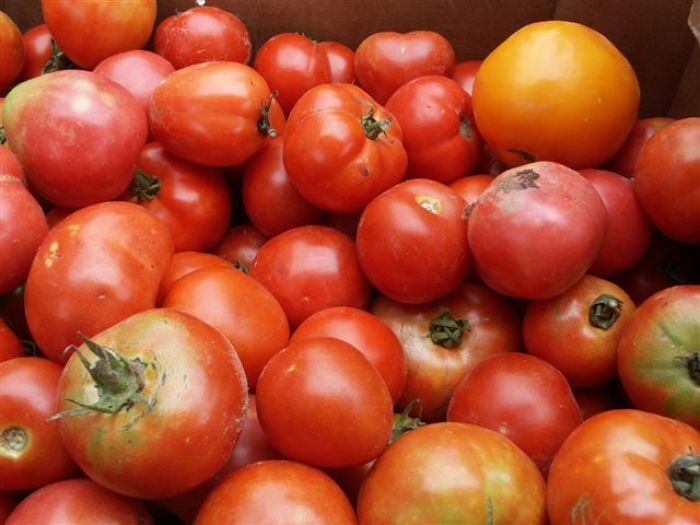
It is that laid-back lazy hazy days of summer time. It is almost too hot to go out to the garden during the day, so many gardeners get up early in order to get weeding, watering and garden chores done before the heat of the day arrives. If I have time, I often plan what to have for supper, harvest and cook it in the morning, so I don’t have to heat up the house later in the day.
When we built our passive-solar house 28 years ago we did not install air-conditioning, just ceiling fans, cool air tubes running underground and turbines on the roof. So on these dog days of summer when it is in the high 90s for days on end, the dog lays around panting and I don’t glow, I sweat. Therefore I do not like to cook much, or do so minimally, and I think about cool foods. However, I am not always so organized and often head out to the garden before supper, after I have had enough at the computer all day, since that is when I think about what I might want to eat. I get inspired by what is ripe and ready and that is usually what is for dinner.
Since I am a traveling gardener (I know that is an oxymoron), my garden is sadly lacking this year. I didn’t get as much planted as in years past, and just one quick weekend out of town and those darn weeds are right back where it was just weeded. A few trips out of town, or a trip to Greece and the weeds near about take over. I supplement my lack of produce with my local farmers’ market and produce stands—and even there—I buy what looks good and meals form in my mind as I spy fat purple-striped eggplants or an array of red and green chiles.
Recently, I was in Greece, on the island of Syros which is located in the Cyclades, where I taught a Holistic Herbal Mediterranean diet class for the American College of Healthcare Sciences’ study abroad course (see more at www.achs.edu). This was not a diet class—it was about eating healthily concentrating on fresh fruit, vegetables, herbs, grains, nuts, some dairy, etc. The summer fare in Greece is what is grown locally—there is no out-of-season produce—except for bananas and I did see a few pineapples. Every taverna serves tomatoes, cucumbers, eggplant, squash, potatoes and peppers; as well as fresh fruit, usually melons for dessert. These vegetables are made into salads, main dishes and sides and served in small portions, so you can sample a few plates and I never tired of them since there are infinite variations with herbs, garlic, olives, capers and olive oil.
For instance, eggplant was served as a dip/spread—sort of like a babaghanoush—pureed with tahini or olive oil or yogurt and lemon and garlic and herbs and served with pita or bread. A favorite preparation of mine came as a salad after being sautéed in chunks and combined with tomatoes, capers, herbs and garlic. And it also came stuffed with rice or breadcrumbs, baked in moussaka or pastitsio, and baked on its own with olive oil, tomatoes, onions and topped with cheese—which literally melted in your mouth.
It is too hot in the Greek isles to grow lettuce in the summer, as it is here in my zone 7 garden. So they don’t eat lettuce there in the summer; they use greens like arugula, dandelion, purslane, and they have a very hardy green called vlita or horta which reminds me of a large spinach plant with tougher leaves, though a little stronger and just slightly bitter in taste. They use these in salads, wilt the horta as a cooked green with lots of garlic and also add them to spanakopita. I never saw a Greek salad with lettuce like the ones we get in restaurants here. Summer Greek Salad consists of a plate of sliced cucumbers, covered with a layer of sliced tomatoes (some of the best I have ever eaten—acid, tart and sweet—very meaty and dripping with juice), then another layer of sliced feta (never crumbled), drizzled with olive oil and sprinkled with capers and/or olives, sometimes fresh oregano or fresh dill. Every home and every restaurant serves this every day. It is in season, peak food and delicious.
The other traditional dish that is on every table is tzatziki. It is sort of a sauce and a dip and is served with bread. The dish varies from place to place, however the three essential ingredients are thick, creamy, tart Greek yogurt, cucumbers (they mostly grow the English type which are long with few seeds) and garlic. Dill, occasionally mint, salt and pepper, and perhaps just a hint of lemon juice are the variables here. Tzatziki can be eaten with any dish—from bread to fresh sliced tomatoes, grilled vegetables, fish, chicken—whatever you like, even by the spoonful. I am going to leave you with my recipe from my recent cooking class for Tzatziki. And remind you it is the time to eat simply during hot weather and enjoy the immediate garden bounty.
Stay tuned for the recipe for Summer Greek Salad next blog. Yia su!
Fine Gardening Recommended Products

A.M. Leonard Deluxe Soil Knife & Leather Sheath Combo
Fine Gardening receives a commission for items purchased through links on this site, including Amazon Associates and other affiliate advertising programs.

Razor-Back Potato/Refuse Hook
Fine Gardening receives a commission for items purchased through links on this site, including Amazon Associates and other affiliate advertising programs.

Chapin International 10509 Upside-Down Trigger Sprayer
Fine Gardening receives a commission for items purchased through links on this site, including Amazon Associates and other affiliate advertising programs.
























Comments
Log in or create an account to post a comment.
Sign up Log in